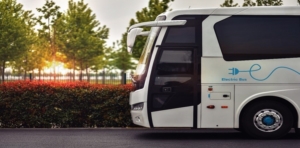
Electric vehicles (EV) should never again be considered ‘futuristic.’ They are the ‘here and now’ and investment funding for electric vehicles is now flowing abundantly from both public and private sector coffers. Billions of dollars are available for electrification projects.
Transit agencies are on the leading edge as they move quickly to electric vehicles. The number of zero-emissions buses in service through public transit agencies has more than doubled over the last three years and that growth pattern will increase exponentially over the next three years.
The Federal Transit Administration (FTA) will disburse $1.7 billion in 2022 for vehicle electrification projects and the funding will be flowing by mid-August. Annual disbursements of more than $1 billion will continue through the 2026 fiscal year.
California, New York, New Jersey, Michigan, Connecticut, and a few other states have mandated that transit agencies electrify their entire fleets. The state of Connecticut is currently developing a roadmap to electrify both transit fleets and paratransit garages as well. State officials are working from a Master Electrification Roadmap to identify facility needs and all funding sources for statewide fleet electrification. A $11.4 million federal grant will be used by the state’s Department of Transportation (DOT) to purchase 22 new electric transportation buses and have them operational by the end of 2023.
New York will replace 50,000 diesel buses with a fully electrified fleet and require all public-school buses purchased after 2027 to be electric. Over the next fiscal year, the state will spend $17 million to replace all of its diesel light-duty vehicles with electric models. The state DOT will also distribute $20 million to transit agencies to support local fleet electrification projects. These activities are part of the state’s third annual installment of a $100 million pledge of funding for electric vehicles over the next five-years.
Michigan has allocated $10 million in the 2023 fiscal year to support electrification of vehicle fleets. The state will electrify all of Michigan’s light-duty vehicles as well as its fleet of medium and heavy-duty vehicles. The governor has announced an even greater expansion of funding options to support electrification projects at the local and school district level, especially in areas wherein air pollution is high.
In Maryland, lawmakers are requiring the state Transit Administration (MTA) to purchase only zero-emission buses and state officials have allocated funding for seven new electric buses. Funding is also available for the construction of MTA’s first 100 percent electric bus facility. Another MTA facility specifically for zero emission buses is planned. Officials in Montgomery County were allocated millions of dollars for local fleet electrification efforts and between 2023 and 2024, the county has a budget of $40 million for the purchase of electric buses.
California’s plan to spend $6.1 billion in support of electric vehicle initiatives has been launched. A $54 million investment has already led to progress on the Sonoma Regional Bus and Rail Connectivity Improvements plan. That funding will be used to purchase 30 zero-emission buses and construct the necessary EV charging infrastructure. The Sonoma County Transportation Authority, Sonoma County Transit, Sonoma Marin Area Rail Transit, Petaluma Transit, Santa Rosa CityBus, and Mendocino Transit Authority are all partners in the effort, and all will receive funding.
Another California-based transit agency, the San Diego Metropolitan Transit System, has allocated $42 million for a project that similarly emphasizes fleet electrification.
The Anaheim Transportation Network (ATN) is undertaking a large electrification project to comply with state-mandated deadlines. The ATN project requires an investment of $48 million to create a zero-emission transit ecosystem which will be operational by the 2028 Olympics. The effort will include the purchase of seven battery electric vans. The project’s budget also includes funding for twenty-five zero-emission buses and ten standard EVs as the basis of a microtransit fleet to improve first/last mile connectivity.
The city of Glendale is partnering with another community on a $47 million large-scale fleet electrification project. The initiative includes the purchase of 27 electric buses to provide service between Glendale Transportation Center and the Glendale Community College and the construction of a new parking deck to accommodate EV charging infrastructure. This project will launch in 2023.
The transit agency for Washington’s Kitsap County has a federal grant of $10.4 million and $2.6 million in matching funds for fleet electrification. The plan is to purchase ten new electric buses and related charging infrastructure. In addition, Washington’s Clark County Public Transportation system (C-TRAN) also has a $3 million grant to further electrify its fleet. The funding will help to finance the county’s purchase of six low-emission, renewable diesel buses which will begin the replacement of its diesel bus fleet. Over the following two years, C-TRAN will replace all 28 diesel buses with low-emission vehicles.
These examples are all related to transit authorities, but funding is flowing for electrification projects of all types. EV charging station infrastructure will soon be evident throughout the country. Electric vehicles are, without doubt, the future in America.
